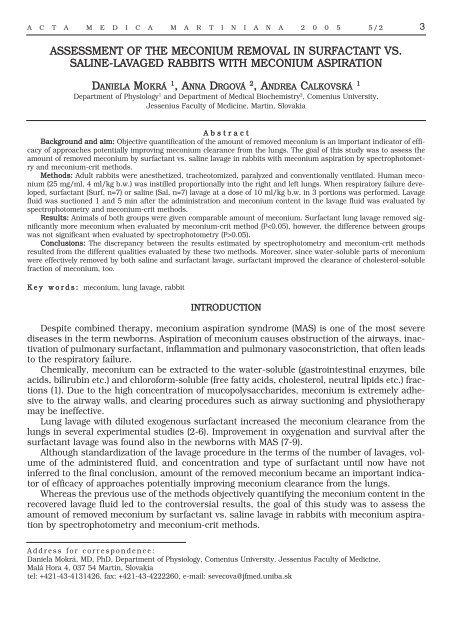MAKETA 5/2 po
MAKETA 5/2 po
MAKETA 5/2 po
You also want an ePaper? Increase the reach of your titles
YUMPU automatically turns print PDFs into web optimized ePapers that Google loves.
A C T A M E D I C A M A R T I N I A N A 2 0 0 5 5/2 3<br />
ASSESSMENT OF THE MECONIUM REMOVAL IN SURFACTANT VS.<br />
SALINE-LAVAGED RABBITS WITH MECONIUM ASPIRATION<br />
DANIELA MOKRÁ 1 , ANNA DRGOVÁ 2 , ANDREA CALKOVSKÁ 1<br />
Department of Physiology 1 and Department of Medical Biochemistry 2 , Comenius University,<br />
Jessenius Faculty of Medicine, Martin, Slovakia<br />
A b s t r a c t<br />
Background and aim: Objective quantification of the amount of removed meconium is an im<strong>po</strong>rtant indicator of efficacy<br />
of approaches <strong>po</strong>tentially improving meconium clearance from the lungs. The goal of this study was to assess the<br />
amount of removed meconium by surfactant vs. saline lavage in rabbits with meconium aspiration by spectrophotometry<br />
and meconium-crit methods.<br />
Methods: Adult rabbits were anesthetized, tracheotomized, paralyzed and conventionally ventilated. Human meconium<br />
(25 mg/ml, 4 ml/kg b.w.) was instilled pro<strong>po</strong>rtionally into the right and left lungs. When respiratory failure developed,<br />
surfactant (Surf, n=7) or saline (Sal, n=7) lavage at a dose of 10 ml/kg b.w. in 3 <strong>po</strong>rtions was performed. Lavage<br />
fluid was suctioned 1 and 5 min after the administration and meconium content in the lavage fluid was evaluated by<br />
spectrophotometry and meconium-crit methods.<br />
Results: Animals of both groups were given comparable amount of meconium. Surfactant lung lavage removed significantly<br />
more meconium when evaluated by meconium-crit method (P0.05).<br />
Conclusions: The discrepancy between the results estimated by spectrophotometry and meconium-crit methods<br />
resulted from the different qualities evaluated by these two methods. Moreover, since water-soluble parts of meconium<br />
were effectively removed by both saline and surfactant lavage, surfactant improved the clearance of cholesterol-soluble<br />
fraction of meconium, too.<br />
K e y w o r d s : meconium, lung lavage, rabbit<br />
INTRODUCTION<br />
Despite combined therapy, meconium aspiration syndrome (MAS) is one of the most severe<br />
diseases in the term newborns. Aspiration of meconium causes obstruction of the airways, inactivation<br />
of pulmonary surfactant, inflammation and pulmonary vasoconstriction, that often leads<br />
to the respiratory failure.<br />
Chemically, meconium can be extracted to the water-soluble (gastrointestinal enzymes, bile<br />
acids, bilirubin etc.) and chloroform-soluble (free fatty acids, cholesterol, neutral lipids etc.) fractions<br />
(1). Due to the high concentration of muco<strong>po</strong>lysaccharides, meconium is extremely adhesive<br />
to the airway walls, and clearing procedures such as airway suctioning and physiotherapy<br />
may be ineffective.<br />
Lung lavage with diluted exogenous surfactant increased the meconium clearance from the<br />
lungs in several experimental studies (2-6). Improvement in oxygenation and survival after the<br />
surfactant lavage was found also in the newborns with MAS (7-9).<br />
Although standardization of the lavage procedure in the terms of the number of lavages, volume<br />
of the administered fluid, and concentration and type of surfactant until now have not<br />
inferred to the final conclusion, amount of the removed meconium became an im<strong>po</strong>rtant indicator<br />
of efficacy of approaches <strong>po</strong>tentially improving meconium clearance from the lungs.<br />
Whereas the previous use of the methods objectively quantifying the meconium content in the<br />
recovered lavage fluid led to the controversial results, the goal of this study was to assess the<br />
amount of removed meconium by surfactant vs. saline lavage in rabbits with meconium aspiration<br />
by spectrophotometry and meconium-crit methods.<br />
Address for corres<strong>po</strong>ndence:<br />
Daniela Mokrá, MD, PhD, Department of Physiology, Comenius University, Jessenius Faculty of Medicine,<br />
Malá Hora 4, 037 54 Martin, Slovakia<br />
tel: +421-43-4131426, fax: +421-43-4222260, e-mail: sevecova@jfmed.uniba.sk

















